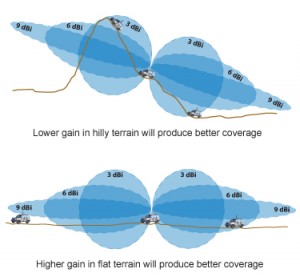When looking at mobile two-way radio coverage, many users jump to the conclusion that the higher the gain rating is on an antenna, the better the coverage. That is not necessarily the case. In this blog, we take a look at the conditions that may affect coverage and help you select the appropriate gain antenna for best results.
Antennas do not make power; they only propagate radio waves. Different antenna designs have different propagation patterns. Unity gain (equivalent to 0 dB gain) ¼ wave antennas propagate RF in an omnidirectional, or circular pattern. Since an antenna does not make power, increasing gain in one direction will decrease propagation in another. Typically, antennas with gain will lose the vertical propagation or “roundness” of the pattern and become flattened and elongated with the higher gain antenna you choose. As you can see in the illustration, using a gain antenna may cause poor performance in a hilly environment.
Mobile antenna choice has a lot to do with the physical terrain. On an open and flat highway, a high gain antenna will be better…3 dB, 6 dB, etc. If your desired coverage area is hilly then a ¼ wave omnidirectional antenna will be better.
The other type of gain is directional and is important for base stations. These are usually called “yagi” antennas. As an educational metaphor, let’s compare gain to a flashlight. When you turn the bezel of a flashlight you are not increasing the power, you are focusing the light and making the energy denser in that area. In RF, for every 3db of gain you double the power. In the world of antennas, you do not double the output, you double the density of signal level in a given area. For the purpose of a fixed base station transmitting to a (stationary) repeater, a high gain Yagi may be used to focus the RF energy directly at the receiving antenna. If you are using a fixed base station and transmitting to a mobile fleet of vehicles, a more traditional omnidirectional propagation would be better suited.
In conclusion, as with many things, your antenna gain choice depends on several factors. Generally, in the Pacific Northwest, we tend to recommend 3 dB antennas for mobile radio users in order to account for both distance and our hilly terrain. Your individual needs may not fit a one-size-fits-all approach. Speak with us today — w are more than happy to discuss your specific application and make recommendations for your specific needs.